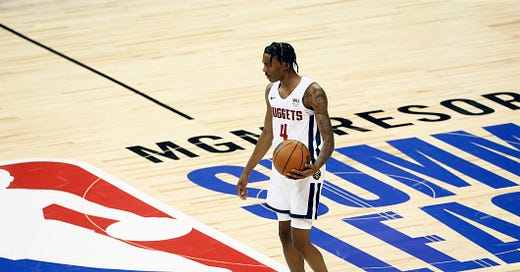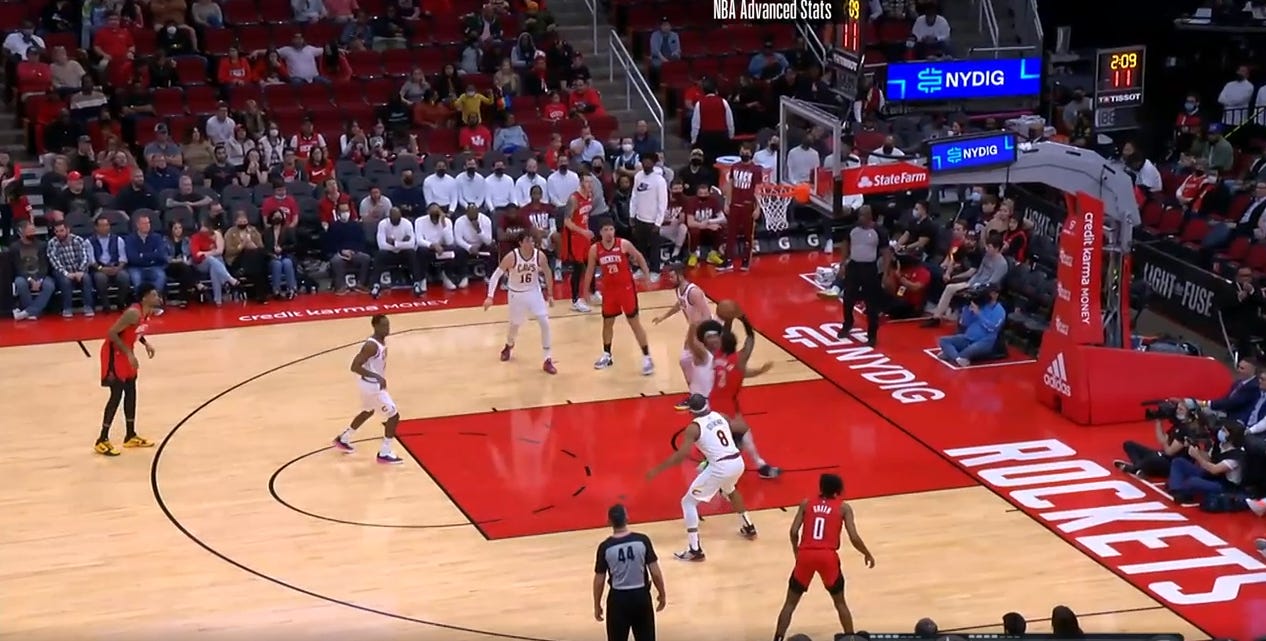As every season begins, there are always a few players that bear extra scrutiny. Some are approaching make-or-break years personally, and some need to perform well for their team to meet expectations. That list was longer than usual this year, so I will break it up by position groups. I tried to stay away from the obvious choices, like rookies, injury returns, and All-NBA candidates (and Ben Simmons; we’ll all be watching Ben Simmons), partially because enough ink is spilled on their behalf and partially because I want you all to think I’m a cool basketball hoopster who’s on the finger-pricking edge of what’s hot. So humor me, please, as we look at three players unlikely to be All-Stars but whose development is at an inflection point.
Markelle Fultz, Orlando Magic
I recently talked about Franz Wagner and Paolo Banchero, two plus-size playmaking wings, so I won’t repeat myself too much. But adding those two to the rising Wendell Carter Jr. at center (he averaged a quietly monstrous 18 points and 11 rebounds after the New Year!) gives the Magic a weirdly inverted offense, where most of the offensive possessions could and should revolve around those three.
But the healthy return of point guard Markelle Fultz complicates things. The former number-one overall pick still can’t shoot from deep and is at his best knifing into the paint and distributing to others. He’s clearly talented, but he’s also a suboptimal fit with Orlando’s future cornerstones.
It’s difficult to tell how the Magic will divvy up the offense. Coaches claim a team can never have too much ballhandling and passing, but I wonder if this Magic team will put that to the test.
Personally, I’m heavily biased against point guards who aren’t a threat from range (see: Murray, Dejounte). They make it extremely difficult to build an effective offense on a successful team, so I’ll be carefully watching how Orlando manages Fultz. His passing is sublime, and he can get into the paint and finish at a very high level — he shot 72% at the rim last season on a small sample, a Giannis-like number. He’s by no means a bad player, but his skillset and weaknesses overlap too much with Orlando’s younger, more promising players for my liking. The complete absence of shooting on the roster threatens to choke out the offense, and putting Fultz in command of the offense might limit the on-ball playmaking opportunities of Orlando’s younger stars.
Then again, the team scored more points with Fultz on the floor than off, and they defended at a higher level, too. Part of the team’s decline when he sat was thanks to the Magic’s extraordinarily bad bench units from last season, but Fultz possesses a real knack for getting his teammates easy buckets — the team shot significantly higher percentages around the rim when he’s on the floor for each of the last two seasons. He’s a master of aesthetically pleasing dump-off passes to cutting teammates:
FILTHY. I’ve changed my mind. He’s only 24, himself. Fultz forever!
Defensively, Markelle was solid last year, showcasing a high motor and a nose for the ball. His impact on that end will improve as he gets more time on the court. He was a little aggressive in overhelping and was a bit rusty, but that was to be expected, given his long injury layoff.
I don’t know what Orlando will do, but they’ll be a fascinating study as they try to figure out who can be a part of a winning future. At the very least, this promises to be the most enjoyable Magic team in quite some time, and watching how they try to mishmash all of these disparate parts together will be a big part of the fun.
Kevin Porter Jr., Houston Rockets
KPJ is his own worst enemy.
Ugly incidents, erratic decision-making, and immaturity on and off the court caused Cleveland to give up on the 2019 first-round pick rather quickly despite tantalizing flashes of play. Houston was happy to take a chance on the talented guard, although he’s a strange fit next to last year’s #2 pick, Jalen Green. Both Green and Porter are shoot-first guards by nature, and the pecking order hasn’t been as firmly established as you’d like.
But when KPJ is playing well, he looks like a future All-Star. He has averaged over six assists per game each of the last two seasons, and he made an effort to be more of a distributor when sharing the floor with Green.
Porter’s signature play is the underhanded pass. He slings it all over the floor with dexterity, like here, when he finds a cutting Green with a nice feed:
That’s tasty! It’s a great little play to weaponize Green’s off-ball shooting by faking the curl at the three-point line and instead doing a 45 cut* for an easy bucket.
Often, KPJ makes up his mind from the get-go that he’s going to shoot, and he doesn’t show the flexibility to adjust if a teammate gets open. Look at this screenshot I took from a game in February. KPJ is about to take a tricky, leaning runner from inside the paint against Jarrett Allen, one of the best rim protectors in the league. He doesn’t even register that his drive has opened up Green, #0, in the strongside corner. Better playmakers know where teammates are at all times.
He turns the ball over on 16% of his possessions, too, which is way too much.
But KPJ is capable of finding open guys when he wants to be, and he’s more than capable of hitting shots. Porter shot nearly 40% from three after the All-Star break last season on a difficult diet of attempts. He shot better as the season went along, particularly from two-point range, and he and Jalen seemed to find a better groove with more experience together. Lineups with Green and Porter got to the rim with ease and bombed threes in classic Rockets style. Those groupings even shot well from those locations, a promising sign considering young players typically improve their accuracy with strength and time.
Unlike Jalen, who experienced typical rookie struggles learning how to play NBA defense, KPJ was one of the better defenders on the Rockets (which is like calling him the sharpest circle, to be fair). He’s 6’4” and strong, capable of using his size to overwhelm point guards and hold up against bigger wings. He gambles for steals a bit much for my liking, but it’s not like Houston was getting stops anyway. Turnovers were pretty much the only defensive successes Houston had! The Rockets threw him into the fire and had him guard the other team’s toughest assignments (his most common assignments included Steph Curry, Shai Gilgeous-Alexander, and *double-checks notes*, uh, LeBron James), and he generally held his own — when he wasn’t moping. KPJ tended to let outside factors or his own struggles influence his effort on the defensive end, but that hopefully is something he’ll correct on a better team and with more maturity.
I’ve never been a huge KPJ fan, but I was impressed with his defensive abilities last season to a degree that made me rethink his trajectory. There’s a world where he’s a 20-point, eight-assist point guard capable of anchoring the offense and stymying the point of attack on defense. That player archetype fits on almost any team.
If Porter can gain some physical and mental consistency, the Rockets might already have their backcourt of the future, overlapping skills or not. I’m genuinely curious to see how much he can improve this season.
Bones Hyland, Denver Nuggets
Bones came by his moniker honestly: he might be the scrawniest-looking guard in the league. Even his skeleton seems thin.
Hyland was listed at 6’3”, 170 as a rookie last season, but both measures seem wrong. He’s deceptively fast, using those long legs for a loping stride that eats up ground, and although he isn’t an explosive athlete, he’s able to worm his way to the hoop with more success than you’d expect.
Bones’ passing was better than advertised as the backup point guard on the Nuggets, and he nailed a bevy of extra-long-range, off-the-dribble jumpers. Just look at his last three-pointer of the season, which came amidst a barrage of quick Bones bombs during a two-minute stretch:
The sheer chutzpah required to shoot a heat check from that deep with 20 seconds left on the shot clock in the playoffs is astonishing.
That confidence and verve will be vital to a Nuggets team that fancies itself a contender. Many had Denver as a championship-level team two years ago after they traded for Aaron Gordon and began destroying the league, but primary perimeter scorer and playoff monster Jamal Murray tore his ACL shortly before the playoffs, killing the dream for both that season and the entirety of the next one.
The rest of the league didn’t sit on their laurels, and the finally healthy Nuggets find themselves in a conference that’s even stronger than it was two years ago. But Murray is coming back, and Michael Porter Jr., too, an electric scorer in his own right. Jokic is the two-time MVP, Gordon is the wing stopper and cutter extraordinaire. The Nuggets traded uber-dependable point guard Monte Morris for Kentavious Caldwell-Pope, a classic 3-and-D guard, in a move that simultaneously bolsters the starting lineup and frees up a bigger role for Bones.
The Nuggets need more scoring pop from their backups. Morris was a superb backup point guard, more well-rounded than Bones, but he was a caretaker, not a bucket-getter. Every successful playoff team needs a minimum of two bench guys who can hold their own when the competition ramps up, defenses key in, and every minute matters. The Nuggets’ other big offseason addition, Bruce Brown, is a fun, do-everything wing (sort of?) who can fill a variety of roles, but he’s not the instant offense that Denver’s bench has been seeking for years. The Nuggets are counting on Bones for that. If he can turn into a legitimate scoring threat off the bench, a poor man’s Jordan Poole, the Nuggets will have enough firepower to compete at any level.
I think Bones will respond well to an increased offensive role. Defensively, however, his slight frame will make him an easy target. He needs to compete harder on that end to be able to stay on the court long enough to showcase his offensive gifts.
This Nuggets team is talented and loaded for bear, but the top of the West might still be just a tiny smidge better. If Bones can exceed expectations, though, Denver’s championship outlook becomes much more realistic.
*a 45 cut is exactly what it sounds like, a cut from the elbow area directly to the hoop at a 45 degree angle to the basket.





![[optimize output image] [optimize output image]](https://substackcdn.com/image/fetch/$s_!UpcM!,w_1456,c_limit,f_auto,q_auto:good,fl_lossy/https%3A%2F%2Fbucketeer-e05bbc84-baa3-437e-9518-adb32be77984.s3.amazonaws.com%2Fpublic%2Fimages%2F6b295abd-9016-482f-8900-906df1a77e96_600x338.gif)
![[optimize output image] [optimize output image]](https://substackcdn.com/image/fetch/$s_!3kxu!,w_1456,c_limit,f_auto,q_auto:good,fl_lossy/https%3A%2F%2Fbucketeer-e05bbc84-baa3-437e-9518-adb32be77984.s3.amazonaws.com%2Fpublic%2Fimages%2F9c1900ac-5824-40fa-b605-bdf15d8910d5_600x338.gif)
![[optimize output image] [optimize output image]](https://substackcdn.com/image/fetch/$s_!RC9f!,w_1456,c_limit,f_auto,q_auto:good,fl_lossy/https%3A%2F%2Fbucketeer-e05bbc84-baa3-437e-9518-adb32be77984.s3.amazonaws.com%2Fpublic%2Fimages%2F54737673-295b-4683-8a3b-49f6ad176a60_600x338.gif)

![[optimize output image] [optimize output image]](https://substackcdn.com/image/fetch/$s_!6MWS!,w_1456,c_limit,f_auto,q_auto:good,fl_lossy/https%3A%2F%2Fbucketeer-e05bbc84-baa3-437e-9518-adb32be77984.s3.amazonaws.com%2Fpublic%2Fimages%2Ff6ef7378-0060-46af-b40d-96ca9d154e97_600x338.gif)